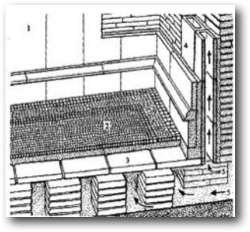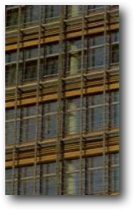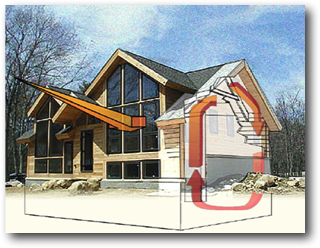ENERTIA HOMES
No Fuel? No Power? .......No Problem
DOUBLE SHELL CONCEPT
The double shell concept for buildings has been around since the Roman days, when they were called hypocaust buildings. It was the earliest form of radiant floor and wall heating. It still works today, using the sun’s energy, and is simple and foolproof- not dependent on fuel or electricity. Most importantly, the outer shell ‘fools’ the inner shell, or living space, into behaving like it is in a different, far more temperate climate.

Roman Double-Shell Building
Often called a “house-within-a-house,” today the method is not that extreme, and it does not mean two separate structures. Modern strong materials, and clever engineering, make it fairly easy. For instance the same set of rafters supports the outer shell roof as the inner shell ceiling. The basement and attic serve as the separation on the bottom and top of the structure. A glass sunroom, aptly called a “conservatory” in the past, separates the shells on the south, so only the double north wall stands out as different.
Many commercial buildings use the double shell concept. In fact, some commercial double-shell buildings use the temperate outer shell space as a lobby.
Many commercial buildings use the double shell concept. In fact, some commercial double-shell buildings use the temperate outer shell space as a lobby.

Debis Building

A Double Shell building is the only building where you can have natural ventilation, and air-conditioning, at the same time. You can AC the inner shell, while you vent the outer shell. Since heat is carried off by natural rising air currents, the AC cost is extremely low.
In the 1980’s a building system was developed by Enertia® to make the double shell concept easy, safe, and affordable for private residences. By using the energy-storing ability of the structure’s material, Enertia® adapted the concept to solar- which requires energy storage from day to night.
The Enertia® double shell is unique in that it not only protects and buffers the inner shell, it adds energy during the day when the sun is out.
In the 1980’s a building system was developed by Enertia® to make the double shell concept easy, safe, and affordable for private residences. By using the energy-storing ability of the structure’s material, Enertia® adapted the concept to solar- which requires energy storage from day to night.
The Enertia® double shell is unique in that it not only protects and buffers the inner shell, it adds energy during the day when the sun is out.
The advantages of the Double Shell are many:
Buffer Zone
The outer shell tempers the inner shell (living space) by creating a false climate based on the outer shell's connection to the earth (moderate temperature) and input from the sun (greenhouse effect)
Summer Cooling
The outer shell can be vented in summer, while the inner shell, which remains sealed, can be air-conditioned. Often the AC is only dehumidifying as the earth-contact keeps the living space at a comfortable temperature. In low humidity climates, like the western United States, no AC is even needed.
Security
Redundancy: If the outer windows or roof are damaged in a storm, the inner shell still is a layer of protection- you can still live there, and your possessions are safe until you get the outer shell repaired.
Strength
Strength: The double north wall is interlaced with steel ties, so looking from the top down is is like a bridge truss laid flat. The strength of that wall is more than the sum of the strength of each single wall. With the correct tie-downs (which can be hidden in the cavity part, a double wall can be engineered for up to 240 mph winds- more than a category 5 hurricane. [photo of double wall under construction with ties]
Control
Control: By opening and closing internal windows and doors you are in control, and can tweak the inner shell conditions. Some of our homeowners have likened it to sailing a sailboat. [photo of north wall windows]
Health
Lower and healthier living space air temperatures. The problem with a forced-air heating system is that air must be heated 10-15 degrees warmer for the body to feel comfortable, than with radiant heating. This means you are breathing this hot air, which leads to the exhausted and sleepy feeling we are familiar with in winter. With radiant heating as the only heating in the inner shell living space (all convection is confined to the outer shell) you are breathing cooler air- you feel invigorated, not sleepy.
Quiet
Sound Control: Inside the inner shell it is incredibly quiet. Street noise is adsorbed by, and contained by the outer shell. The superior acoustics of the solid wooden walls have been noted by musicians who have built our homes.